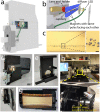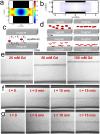Sickle cell detection using a smartphone
- PMID: 26492382
- PMCID: PMC4615037
- DOI: 10.1038/srep15022
Sickle cell detection using a smartphone
Abstract
Sickle cell disease affects 25% of people living in Central and West Africa and, if left undiagnosed, can cause life threatening "silent" strokes and lifelong damage. However, ubiquitous testing procedures have yet to be implemented in these areas, necessitating a simple, rapid, and accurate testing platform to diagnose sickle cell disease. Here, we present a label-free, sensitive, and specific testing platform using only a small blood sample (<1 μl) based on the higher density of sickle red blood cells under deoxygenated conditions. Testing is performed with a lightweight and compact 3D-printed attachment installed on a commercial smartphone. This attachment includes an LED to illuminate the sample, an optical lens to magnify the image, and two permanent magnets for magnetic levitation of red blood cells. The sample is suspended in a paramagnetic medium with sodium metabisulfite and loaded in a microcapillary tube that is inserted between the magnets. Red blood cells are levitated in the magnetic field based on equilibrium between the magnetic and buoyancy forces acting on the cells. Using this approach, we were able to distinguish between the levitation patterns of sickle versus control red blood cells based on their degree of confinement.
Conflict of interest statement
A provisional patent has been filed on the technology described here (#62133031).
Figures




References
-
- World Health Organization. Fifty-Ninth World Health Assembly Resolutions and Decisions Annexes. < http://apps.who.int/gb/ebwha/pdf_files/WHA59-REC1/e/WHA59_2006_REC1-en.pdf> (2006) Access date: 06/30/2015.
-
- Sickle Cell Disease Association of America. Sickle Cell Disease Global: Sickle Cell Disease is a Global Public Health Issue, < http://www.sicklecelldisease.org/index.cfm?page=scd-global> (2014) Access date: 06/30/2015.
-
- National Heart Lung and Blood Institute. What is Sickle Cell Anemia?, < http://www.nhlbi.nih.gov/health/health-topics/topics/sca/#> (2012) Access date: 06/30/2015.
-
- Center for Disease Control and Prevention. Facts About Sickle Cell Disease, < http://www.cdc.gov/ncbddd/sicklecell/facts.html> (2014) Access date: 06/30/2015.
Publication types
MeSH terms
Grants and funding
LinkOut - more resources
Full Text Sources
Other Literature Sources
Medical

